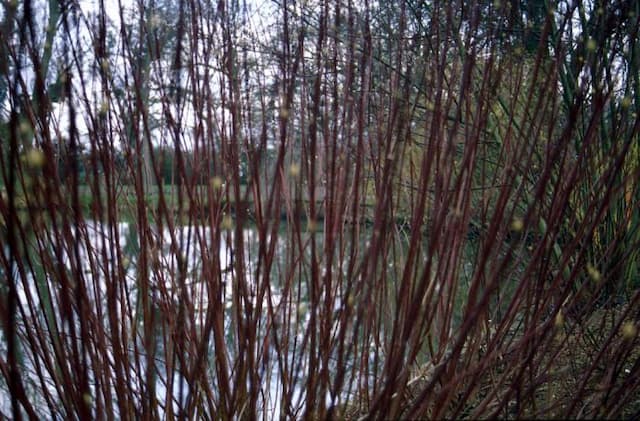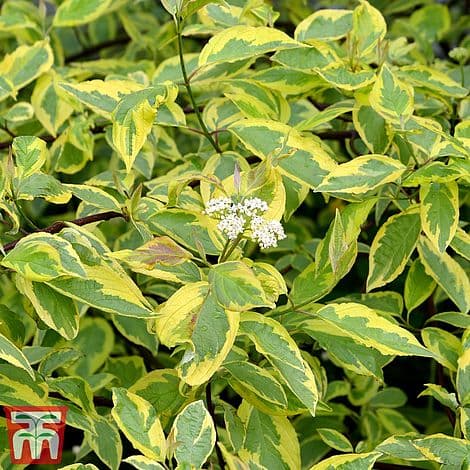Bloodtwig dogwood Cornus sanguinea 'Magic Flame'











ABOUT
Cornus sanguinea 'Magic Flame', commonly known as Bloodtwig Dogwood 'Magic Flame', is a deciduous shrub noted for its striking seasonal appearance. In spring and summer, the plant is adorned with oval to lance-shaped leaves that possess a rich green hue. Come fall, these leaves transform into a brilliant tapestry of oranges, yellows, and reds, bringing a fiery warmth to the landscape. One of the most distinctive features of Bloodtwig Dogwood 'Magic Flame' is its stems. During the growing season, the stems can be somewhat inconspicuous beneath the foliage. However, as the leaves fall, the stems reveal themselves in all their glory. They exhibit a bright yellow to orange color with an overlaid red hue, reminiscent of a flame, hence the name 'Magic Flame'. This vivid stem coloring is particularly remarkable in the winter landscape, providing a bold contrast to the often dull and muted tones of the season. The flowers of Bloodtwig Dogwood 'Magic Flame' are small and creamy white, appearing in clusters during late spring to early summer. These are followed by spherical, blackish-blue fruits that can attract birds and wildlife, adding an additional layer of interest to the plant. Overall, Bloodtwig Dogwood 'Magic Flame' is cherished for its year-round visual interest, with each season bringing its own unique appeal from the vivid leaves to the fiery stems and subtle flowers and fruit.
About this plant
 Names
NamesFamily
Cornaceae.
Synonyms
Bloodtwig Dogwood, Common Dogwood, European Dogwood, Magic Flame Dogwood.
Common names
Cornus sanguinea 'Magic Flame'.
 Toxicity
ToxicityTo humans
Bloodtwig dogwood, commonly known as Cornus sanguinea 'Magic Flame', is not considered highly toxic to humans. However, like many ornamental plants, different parts of the Bloodtwig dogwood, such as leaves, stems, or unripe berries, may contain compounds that can cause stomach upset or discomfort if ingested. The symptoms of ingesting parts of this plant can include nausea, vomiting, or diarrhea. It is always recommended to avoid eating any part of ornamental plants due to their potential toxicity.
To pets
Bloodtwig dogwood, or Cornus sanguinea 'Magic Flame', isn't known to be highly poisonous to pets, but it may cause mild gastrointestinal upset if ingested. The symptoms from consuming parts of the Bloodtwig dogwood might include vomiting, diarrhea, or drooling. Pets, particularly dogs and cats, should be discouraged from eating any part of this ornamental shrub to prevent discomfort or a possible adverse reaction.
 Characteristics
CharacteristicsLife cycle
Perennials
Foliage type
Deciduous
Color of leaves
Varies
Flower color
White
Height
6-8 feet (1.8-2.4 meters)
Spread
5-6 feet (1.5-1.8 meters)
Plant type
Shrub
Hardiness zones
4
Native area
Europe
Benefits
 General Benefits
General Benefits- Ornamental Appeal: Adds vibrant color to landscapes with its fiery red-orange stems in winter and variegated leaves in spring and summer.
- Wildlife Attraction: Berries provide a food source for birds, while flowers attract butterflies and bees.
- Seasonal Interest: Offers year-round visual interest with seasonal changes in foliage, stem color, and flowering.
- Low Maintenance: Requires minimal care once established, thriving in a range of soil types and conditions.
- Drought Tolerance: Can withstand periods of low water availability, making it suitable for drier climates or water-conserving gardens.
- Hardy Nature: Resilient against many common pests and diseases, ensuring longevity in the landscape.
- Erosion Control: Root system helps stabilize soil which can prevent erosion, particularly on slopes.
- Fall Coloration: Leaves turn to a beautiful array of colors in the fall, enhancing autumn landscapes.
- Privacy and Screening: Dense foliage and growth habit can provide privacy and screen unsightly views when planted in groups.
- Versatility: Suitable for a variety of settings including mixed shrub borders, foundation plantings, and as a stand-alone specimen.
 Medical Properties
Medical PropertiesThis plant is not used for medical purposes.
 Air-purifying Qualities
Air-purifying QualitiesThis plant is not specifically known for air purifying qualities.
 Other Uses
Other Uses- Winter Interest: Cornus sanguinea 'Magic Flame', commonly known as the bloodtwig dogwood, exhibits bright, flame-colored stems in the winter that provide a stunning visual display in otherwise barren landscapes.
- Wildlife Habitat: The dense thickets formed by bloodtwig dogwood can provide cover and nesting opportunities for birds and small mammals.
- Bank Stabilization: The fibrous root system of bloodtwig dogwood helps stabilize soil and prevent erosion on slopes and riverbanks.
- Winter Bouquets: The vibrant stems of bloodtwig dogwood can be cut in the winter and used to add color and interest to floral arrangements.
- Natural Fencing: When planted in a row or hedge, bloodtwig dogwood can serve as an attractive and natural fencing option.
- Garden Framework: The sturdy stems can be used by gardeners as natural stakes to support other plants in the garden.
- Educational Tool: Bloodtwig dogwood can be used in educational settings to teach about seasonal changes in plants as its stems change color through the year.
- Photography Subjects: The distinctive winter coloring of bloodtwig dogwood's stems makes it a popular subject for photographers, especially contrasting against the snow.
- Artistic Inspiration: Artists may use bloodtwig dogwood as a subject or as a natural material in environmental art pieces.
- Cultural Symbol: In some cultures, the bloodtwig dogwood may be used in festive decorations due to its bright stem coloration, especially around the Christmas season.
Interesting Facts
 Feng Shui
Feng ShuiThe Bloodtwig dogwood is not used in Feng Shui practice.
 Zodiac Sign Compitability
Zodiac Sign CompitabilityThe Bloodtwig dogwood is not used in astrology practice.
 Plant Symbolism
Plant Symbolism- Transformation: The 'Magic Flame' variety of Cornus sanguinea, commonly known as the Bloodtwig Dogwood, often symbolizes transformation due to its striking transition of leaf colors from green to vibrant shades of orange, red, and purple.
- Resilience: Known for its hardiness and ability to withstand winter temperatures, the Bloodtwig Dogwood represents resilience and the capacity to endure challenging conditions.
- Vitality: With its bright, fiery stem color which is most notable in the winter months, the Bloodtwig Dogwood signifies vitality and a burst of energy, suggesting life even in the dormant season.
- Protection: Traditional plant symbolism often recognises sturdy, robust plants like the Bloodtwig Dogwood as symbols of protection due to their dense growth and the shelter they provide in nature.
 Water
WaterFor the Bloodtwig Dogwood 'Magic Flame', it is best to water deeply once a week, allowing the water to penetrate several inches into the soil to encourage deep root growth. During hot or dry spells, the frequency may increase to twice per week. Each time you water, aim for approximately 1 to 1.5 gallons per plant as a general rule. During the winter, when the plant is dormant, reduce watering to every two weeks or less, depending on the soil moisture.
 Light
LightBloodtwig Dogwood 'Magic Flame' thrives in full sun to partial shade. The ideal spot is where the plant receives at least four to six hours of direct sunlight daily, but it is also tolerant of light dappled shade, especially in hotter climates.
 Temperature
TemperatureBloodtwig Dogwood 'Magic Flame' is hardy and can survive a temperature range from -20°F to 90°F, with ideal growth conditions being between 60°F and 75°F. It should be protected from extreme temperature fluctuations that could damage the plant.
 Pruning
PruningBloodtwig Dogwood 'Magic Flame' should be pruned to remove any dead, damaged, or diseased branches and to shape the plant. The best time for pruning is late winter or early spring before new growth begins. It is also beneficial to periodically remove about a third of the oldest stems to encourage vibrant new growth.
 Cleaning
CleaningAs needed
 Soil
SoilBloodtwig dogwood 'Magic Flame' thrives best in well-draining, fertile loam with a pH of 5.5 to 7.5. A good soil mix would include a combination of garden soil, peat moss, compost, and a little sand to ensure adequate drainage. Mulching will help retain moisture and improve soil quality over time.
 Repotting
RepottingBloodtwig dogwood 'Magic Flame' is typically not a potted plant but rather planted directly in the garden. If grown in containers, repot every 2-3 years or when it outgrows its current pot, using the aforementioned soil mix for best results.
 Humidity & Misting
Humidity & MistingBloodtwig dogwood 'Magic Flame' prefers average to high humidity conditions but is adaptable to different humidity levels outdoors. As long as the soil moisture is well-managed, the humidity is not a critical factor for this hardy shrub.
 Suitable locations
Suitable locationsIndoor
Provide bright light and moist soil for indoor Bloodtwig dogwood.
Outdoor
Plant in moist, well-drained soil with access to full sun or part shade.
Hardiness zone
4-7 USDA
 Life cycle
Life cycleThe life cycle of Cornus sanguinea 'Magic Flame', more commonly known as Bloodtwig Dogwood 'Magic Flame', begins with seed germination in the spring, after a period of cold stratification through the winter that breaks seed dormancy. Following germination, the seedling goes through a vegetative phase, where it develops a root system and foliage through photosynthesis. As the plant matures, it enters the flowering stage, usually in late spring or early summer, producing small white flowers in clusters, which are then pollinated by insects. After pollination, the flowers develop into small blue-black berries by late summer, which are dispersed by birds and other animals, aiding in propagation of the plant. Throughout its life, the Bloodtwig Dogwood 'Magic Flame' undergoes seasonal changes, with leaves turning from green to bright red or orange in the fall, before it becomes dormant in the winter. This deciduous shrub can live for several years, repeating this cycle annually.
 Propogation
PropogationPropogation time
Spring-Early Summer
The Cornus sanguinea 'Magic Flame', commonly known as the Bloodtwig Dogwood, is often propagated through hardwood cuttings. This method is typically carried out in late fall or early winter after the plant has gone dormant. To propagate by hardwood cuttings, one would select healthy, mature stems from the current year's growth and cut them into lengths of about 6 to 9 inches (15 to 23 centimeters), ensuring that each cutting has at least a couple of nodes. The bottom end of the cutting, which is to be planted, should be cut just below a node, and the top end just above a node to maximize potential for growth. The cuttings are then planted in moist soil, with one-third to one-half of their length buried, in a sheltered outdoor spot or cold frame, where they can root over the winter months. It is important to keep the soil moist until the cuttings are well-rooted, which usually takes a couple of months.









